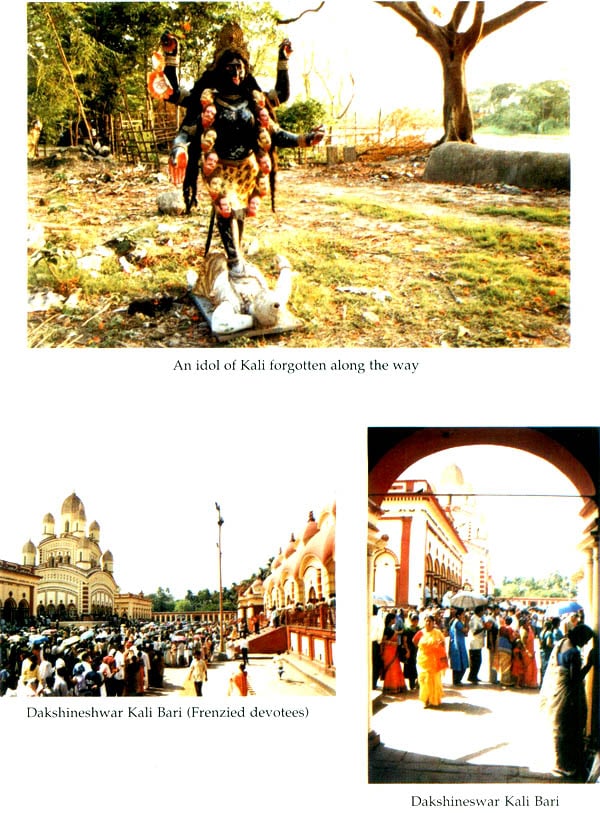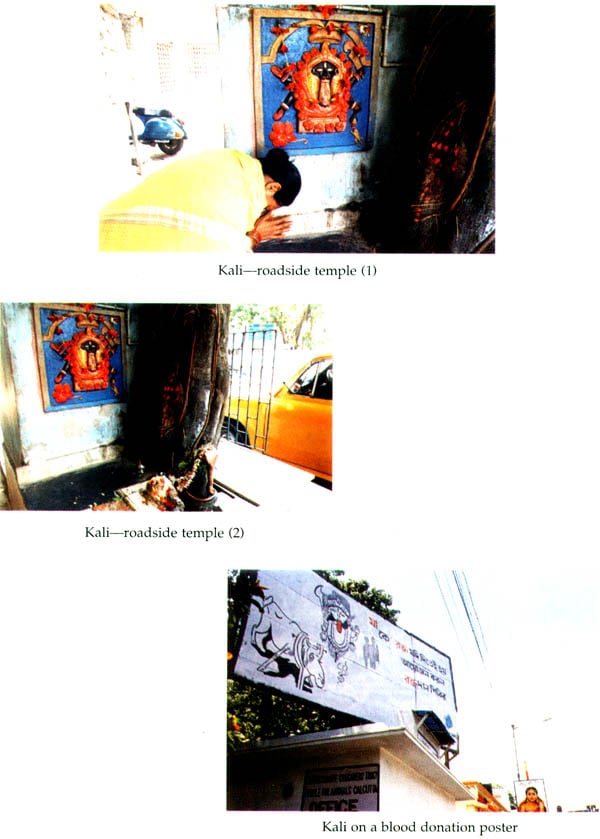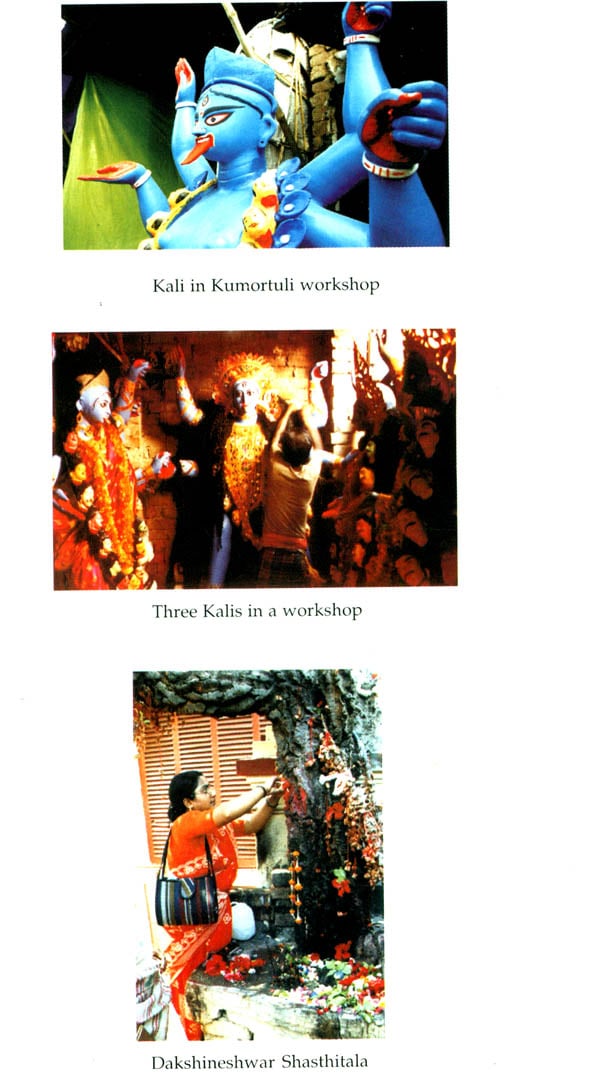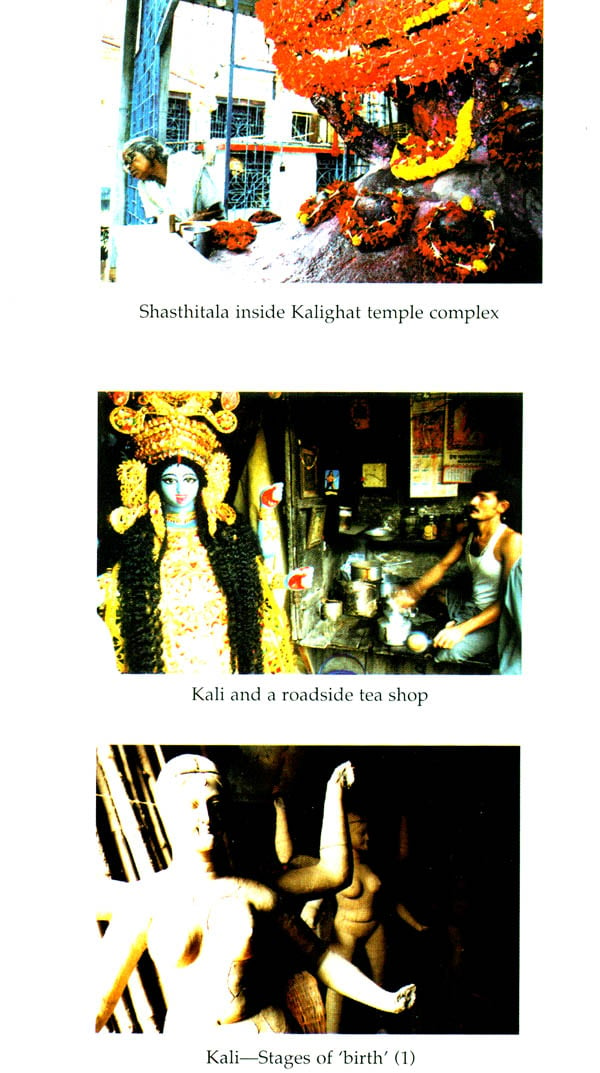
The Goddess Kali of Kolkata
Book Specification
| Item Code: | IDF375 |
| Author: | Shoma A. Chatterji & Photographs By: Nilanjan Basu |
| Publisher: | UBS Publishers Distributors Pvt. Ltd. |
| Language: | English |
| Edition: | 2006 |
| ISBN: | 9788174765147 |
| Pages: | 147 (Color Illus: 63 & B & W Illus: 4) |
| Cover: | Hardcover |
| Other Details | 9.8" X 7.4" |
| Weight | 580 gm |
Book Description
From the Jacket :
The history of the city of Kolkata can never be complete without reference to the Kali temples of the city. The city is doted with temples of Kali, big and small, famous and anonymous, historical and contemporised. Visited by devotees and atheists, religious-minded people and agnostics, Bengalis and non-Bengalis, local, national and international tourists and pilgrims.
The name that comes to the mind when we mention the city is that of Kalighat. It is one of the most famous places of pilgrimage, located in the heart of Kolkata's souther end. Kalighat owes its fame to the famous Kali temple her, founded and established by an erstwhile zamindar family of Kolkata, known as the Sabarno Raychoudhuris, in 1809.
In the Puranas, Kali, 'the back one' emerges from Durga's forehead to destroy the demons, Chanda and Munda and therefore earns the appellation Chamunda. The direct linkages of Tantra with Kali, the black goddess, in its popular form in West Bengal is traced back to Tarapeeth, a Sakta centre in Birbhum district of West Bengal and to Bamakshyapa, a guru at Tarapeeth, said to be a contemporary of Ramakrishna Paramhansa. Legend in Bengal insists that it was the third eye of Sati - the eye of knowledge located on her forehead - that fell at Tarapeeth. With culture in a state of constant flux, the character and role of Kali, the goddess and Kali temples in Kolkata have undergone major transformations. Though popular expectations move around a decline in the consecration of the cultic image of Kali in terms of worship, this has not happened in Kolkata rather the consecration of belief in Kali has multiplied tremendously.
Preface
The history of the city of Kolkata (formerly Calcutta) can never be complete without reference to the Kali temples of the city. The city is dotted with temples of Kali, big and small, famous and anonymous, historical and contemporized, visited by devotees and atheists, tourists and pilgrims, religious-minded and agnostics, Bengalis and non-Bengalis, local, national and international pilgrims, tourists, visitors and regular hangers-on.
This book is a modest attempt to trace how the Kolkata psyche has turned the mythical goodess Kali into a cult figure that has evolved with time into several sites of pilgrimage within the city. It is an ambivalent, ambiguous area where people initially stepped in for religious and spiritual succour, but that later turned into one of the strongest influences within the mindset of the layman of Kolkata, in terms of culture, language, art and social life. Though Kali, the goddess, in terms of scriptures and legends, is specific to the Hindu pantheon, over time she has smoothly gravitated towards becoming universal symbol of worship and devotion. History books and documents defining the origins of the city underscore how even the British rulers had begun to believe in her godly powers of creation, sustenance and destruction. Today, Kali, the black goddess, and the temples dedicated to her within the city of Kolkata are a cosmopolitan and secular icon that has crossed the borders of caste, class, community, age, sex and race. She is a cultural and a social icon as much as a religious one.
The author has attempted to describe some famous Kali temples in terms of their history, the legends that surround their origins, their location, their social association, their religious links, the folk art and their impact on the shaping of Kolkata-the city, its people and their lifestyle. Why does Goddess Kali and temples of her worship have such a special association with the history and evolution of the city of Kolkata? Does it have something to do with the history of the city per se? Or does it have something to do with the Bengali psyche and mindset? If this were true, how is it that non-Bengalis too throng these temples to make their offerings and place their vows? How does one explain the fact that the increasing cosmopoliticization of the population of the city has enhanced and enlarged rather than retarded the popularity of Kali and all that she stands for? These are some of the questions to which this book has tried to find answers. There are no clear answers, but the legends and stories that surround Kali offer some suggestions, more in between the lines than in articulation.
The picture of the socio-cultural universe against which the Kali temples of Kolkata are placed is based on the author's personal investigation and understanding through documentary and field research. These has been an attempt to be objective, yet somewhere along the way, the study has evolved into a subjective analysis at certain points of experience. The end product, therefore, is a fusion of the objective and the subjective. Many a time, this work might appear to be a collage of thought and experience, of fragments drawn, therefore, would best be left to the reader. The contents of the text do not necessarily represent the understanding of any single individual or source, but rather are the most economic generalizations that accommodate the partial views of many sources of information. The argument of this study proceeds from the general to the specific and returns to the general.
Firstly, since this study is intrinsic to the origins of the city of Kolkata, it traces the history of its foundation and evolution. This offers a straightforward glimpse into the city as it appears today and as it was in the beginning. It outlines its demographic profile in terms of its population, density, sex ratio, linguistic, ethnic and communal divisions cultural, artistic and religious affiliations, etc. it explores the confluence of cultures in the designing of the cityscape of Kolkata. It probes into the debate on the issue of whether the city truly owes its existence to Job Charnock or not. Secondly, it tries to explore the naming of the city, often traced back to Kalioghat, that houses one of the two most famous temples dedicated to Kali in the country, and is intricately linked to the history and growth of the city, (the other being the Dakshineswar temple, a small distance away from Kolkata.) The varied ways in which Kolkata, the city, is pronounced, the reasons how these came about, the debate around such pronunciation and so on have been briefly discussed here. Documents and old texts have been the chief source material here. Thirdly, it steps into the ten-most famous Kali temples in the city of Kolkata, reliving the myths that surround their origins to work out the linkages between these temples as places of pilgrimage and local worship and the socio-cultural evolution of the city. In so doing, it also studies the fascination the black goddess in the Hindu pantheon once had among bandits in the state and the city, exploring the causes that probably led to Kali's tremendous popularity among people who killed and looted for a living. Kalighat is not the only famous temple worshipping Kali. These are the Dakshineswar Kali Bari, the Adyapeath near Dakshineswar, the Siddeshwari Kali temple at Baghbazar, the Kali temple at Thanthaniya, the Firingee Kali temple, Puntekali, Byomkali and so on.
Fourthly, this study attempts to go deep into the origins of the Mother Goddess in her varied and colourful permutations, combinations and icons within Hinduism in general and within the Bengali mindset in particular. It also goes into the myths that evolve around the creation of the black goddess and how she has been interpreted in different ways, especially by the tantras. This creates the scope for a brief look at Byamakshapa and his way of interpreting Tantra for the common man.
Fifthly, the study focuses on the origin, history and growth of the Kalighat temple, tracing the culture and economics of the area over the years. The name that comes uppermost in mind when we mention the city is that of Kalighat. The classical name of this historic place is Kali-kshetra. It is one of the most famous pilgrimages in the eastern parts of India, located in the heart of Kolkata's southern end. Kalighat owes its fame to the famous Kali temple here, founded and established by an erstwhile zamindar family of Calcutta, known as the Sabarno Roy Choudhuris, in 1809. Kalighat Temple Road is the open street lined with colourful shops on either side, dotted with tiny temples around corners through lanes and bylanes, leading up to the Kali temple. It is an ancient street that defines its own, distinct history. It is clearly earmarked in city maps of Kolkata dating back to 1759. since the founding of the Kali temple in Kalighat, pilgrims from across the country have been widely using this read to make their way to the temple.
Finally, it tries to discover and present the impact of Goddess Kali in general and Kalighat in particular, defining some of the aesthetic, cultural and social lives of people of Kolkata in the past, through the present and into the future. The city has grown into a post-modernist cauldron of languages, ethnicities, lifestyles, arts, crafts, music, literature and cinema since the time it began with the Kali temples functioning mainly as sites of pilgrimages for pilgrims coming from nearby villages, small towns, and distant lands to find solace in the arms of their favourite Mother Goddess-Kali. They have contributed to the ethnographic culture of the city as much as to its music, its fine arts, its spiritual life, its cinema, its literature and its calendar art. This has also had its negative side such as the practice of sacrifice conducted clandestinely for superstitious reasons, or driving a young couple to suicide for wrong reasons.
Despite 200 years of Western education and urban, commercial and industrial growth in the city of Kolkata, the major Kali temples continue to attract a large number of pilgrims, local, regional, from all corners of the country and also the world. The stubborn persistence of these sacred centres of Kali poses the following questions-how are these centres of pilgrimage sustaining their sacred eminence in the face of constant pressures of modernization and the changing architectural and spatial landscape of the city? What are the trends of change in this adaptive process? It is with these questions in mind that a socio-historical and cultural study of the changing social and cultural milieu of the Kali temples in Kolkata seems appropriate at a time when the city is going through a tremendous metamorphosis in terms of its traditional demographic profile in language, custom, education, ethnic groupings and so on.
About the Author :
Shoma A. Chatterji, based in Calcutta since 1995, is a noted author, freelance journalist and film critic writing for over 20 years. Her areas of specialization are cinema, gender, television, personalities, children, human rights, literature and relationships. She conducts workshops on writing journalism and film appreciation in Mumbai and Kolkata several times a year. She won a commendation for her 'Outstanding Contribution to Women's Issues' from the Eve's Weekly Women Journalist Award in 1988; the National Award for Best Film Critic Award from the Bengal Film Journalists' Association in 1998 and National Award for the Best Book on Cinema in 2003 for the book Parama and Other Outsiders - the Cinema of Aparna Sen. She holds two master's degrees, one in Economics and the other in Education from the University of Mumbai. She also holds a post-graduate diploma in Journalism (First Class First) from Mumbai's Somaiya Institute of Journalism and Mass Communication. She has presented papers at national and international seminars on cinema and gender and has been on the international jury at several international film festivals across Europe. She is a founder member of FIPRESCI-India, an international organization of film critics based in Munich. She has authored four books on gender, four film biographies, two film analyses, three collections of short fiction in English and one collection of Cinema articles in Bengali.
| Acknowledgements | v | |
| Preface | vii | |
| 1. | Kolkata - the City | 1 |
| 2. | The Naming of the City | 14 |
| 3. | Some Noted Kali Temples in Kolkata | 26 |
| 4. | Kali - The Black Goddess | 53 |
| 5. | The Kali Temple of Kalighat | 76 |
| 6. | The Culture of Kali in Kolkata | 95 |
| Bibliography | 125 | |
| Index | 131 |










